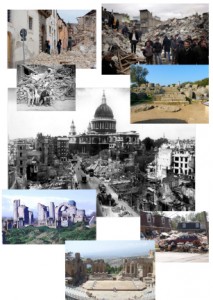Call for papers:
As opposed to the Gothic labyrinths of vaults and broken palaces or shattered abbeys, in the nineteenth century the picturesque legacy grew into a passion for sublime ruins as crystals of time, suffused with melancholy pleasure. From Romantic hubris (and the fascination for Troy or Pompei) to Turner’s luminous visions or Hardy’s carved windows and stone coffins, ruins offered dwindling points of aesthetic stability as well as symptoms of mutability in a changing world stamped by Darwinian ruthlessness. This conference proposes to analyze the hybrid function of ruins as they shift from sublime metonymies to broken hints of shattered times and troubled consciousness, focusing not only on the visual motif of ruins but on the function of citation as an attempt to include the ruined pieces of bygone art and cultural systems, whether the purpose be to “shore fragments” against ruin, as in the case of Modernism, or to challenge and deconstruct present exhaustion and past master discourses, as in the case of post-modernism. The postmodern emphasis on remains, from Ackroyd to Ishiguro or Stoppard, on textual experimentation with broken fragments, the function of architecture and visual motifs will be of interest, showing that twentieth-century British art and fiction revisit ruins not only as the broken pieces of a vanished past, but as artificial to begin with. Emphasis on architecture will necessarily include cultural context, and moments of acute fragmentation such as the Blitz, the British equivalent of the Twin Towers, faultlines leaving not only the smell of smouldering remains, but a division between before and after, an intense sense of the collapse of ideologies and promises. The ultimate negotiation of the bankruptcy of meaning may lead to repetition and elegy or parody, or to the intense attempt to create an ephemeral art retaining the traces of a glorious past but displacing them, leading to brief presences and vanishing points, as residue becomes resistance and art articulates waste.
Programme:
Friday November 4
9.00: Registration
I. From the picturesque to 20th century ruins
- 9.30-9.50: David Shackleton (Oxford), “The Ruins of Time”: H.G. Wells’s The Time Machine
- 9.50-10.10: Catherine Hoffmann (Le Havre, laboratoire Forell, Poitiers), “Vistas framed by a ruined door”: Anthony Powell’s poetics of ruins
- 10.10-10.30: Florence Marie-Laverrou (Pau), Hardyan ruins in A Glastonbury Romance and Maiden Castle, by John Cooper Powys
10.30-11.00: questions
11.00-11.30: coffee break
- 11.30-11.50: Delphine Cingal (Paris 2), Ruins in P.D. James’ The Black Tower: buildings and human beings
- 11.50-12.10: Brian May (Northern Illinois), Modernist Rage Among the Ruins
- 12.10-12.30: Cécile Marshall (Nantes), Ruins, retrieval and recreation in Arcadia and The trackers of Oxyrhynchus; or Tom Stoppard and Tony Harrison staging “Litterrerchewer”
12.30-1.00: questions
II. Modernist fragments
- 2.00-2.20: Kate McLoughlin (Birkbeck, univ. of London), “Two gross of broken statues”: Ezra Pound’s ruiniform tropes
- 2.20-2.40: Rebeca Gualberto Valverde (Complutense, Madrid), “(More than) a Handful of (Shored) Fragments”: Evelyn Waugh’s (re-)appropriation of Arthurian Literary Ruins
- 2.40-3.00: Adèle Cassigneul (Toulouse 2), Virginia Woolf’s ruined house, a temporal complex
3.00-3.30: questions
3.30-4.00: coffee break
- 4.00-4.20: Lauren Elkin (Paris-Diderot/CUNY), Inheriting Modernism: Inside Elizabeth Bowen’s Houses
- 4.20-4.40: Elena Gualtieri (Sussex), “Full of Sinew”: Photography and the Ruin of Time in Mansfield and Derrida
- 4.40-5.00: Thomas Dutoit (Lille 3), Ruins as the Deconstruction of Presence in E. Bowen’s The Heat of the Day (1949) and Michael Moorcock’s Mother London (1985)
5.00-5.30: questions
- 5.30: Le Blanc, Valérie, “The renovation” (video).
Saturday November 5
III. Urban ruins
- 9.30-9.50: Keith Williams (Dundee), Previews of Apocalypse: Ruined London in the Words and Images of H.G. Wells and Contemporaries
- 9.50-10.10: Florence Berlioz (Paris 3), Ruins in Graham Greene’s The End of the Affair and R. Lehman’s The Echoing Grove
- 10.10-10.30: Sophie Aymes (Dijon), Ivy and bones: ruins in blitzed London (pictures, architects, Roger Fry)
10.30-11.00: questions
11.00-11.30: coffee break
- 11.30-11.40: Michel Morel (Nancy 2), Coventry Cathedral, 1962: redeeming the scar into modernity
- 11.40-12.00: Jean-Michel Ganteau (Montpellier 3), Ruins, of the Ethical Logic of traumatic capitalism, with special reference to Peter Ackroyd
- 12.00-12.30: Sylvie Maurel (Toulouse 2), Rubble in Atonement by Ian McEwan
12.30-1.00: questions
IV. Pictorial and photographic ruins
- 2.00-2.30: Frédérique Amselle (Valenciennes), British self-portraits or the Remains of the Self (Bacon, Freud, Auerbarch)
- 2.30-2.50: Karen Brown (Dublin), “Giorgionesque Elucidations”: Thomas MacGreevy’s pictorial poems and the aesthetics of waste
- 2.50-3.10: Liliane Louvel (Poitiers), Reading with images: Anita Brookner’s The Next Big Thing as memento mori
3.10-3.30: questions
3.30-4.00: coffee break
- 4.00-4.20: Anne-Laure Fortin-Tournes (Le Mans), The Ruin as kairos in Sebald’s The Rings of Saturn
- 4.20-4.40: Guillaume Evrard (Edinburgh), Ruins of everyday life: Steffi Klenz’s Nummianus (2007-08)
4.40-5.00: questions
